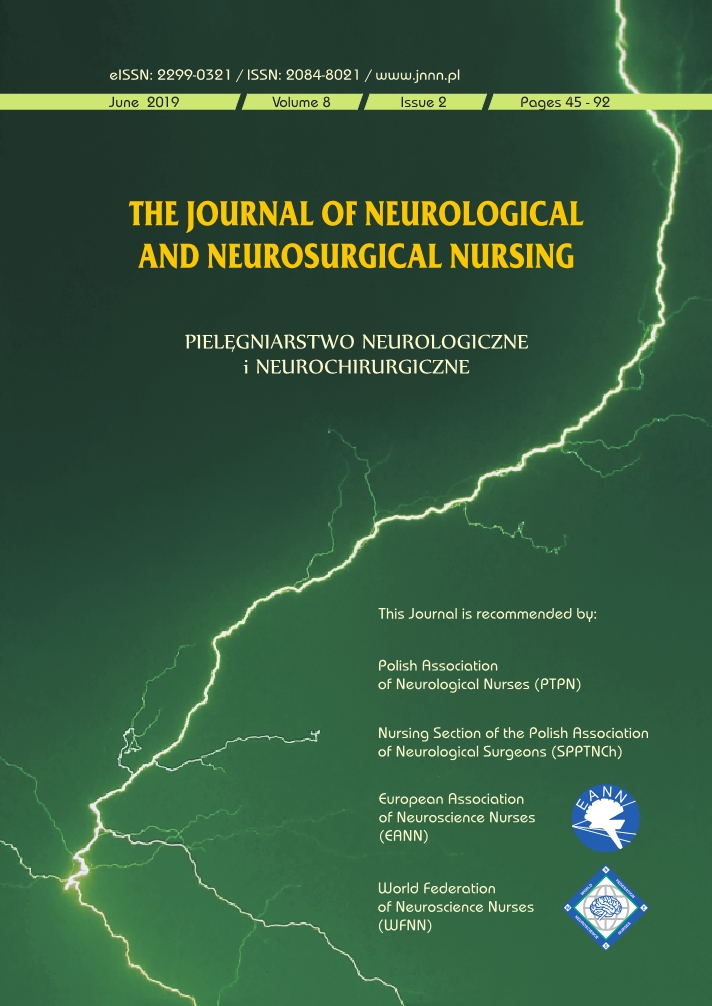Jakość życia uwarunkowana stanem zdrowia według EQ-5D-3L u chorych w okresie 5 lat po udarze mózgu
DOI:
https://doi.org/10.15225/PNN.2019.8.2.3Słowa kluczowe
udar mózgu, zdrowienie, jakość życia, EQ-5D-3LAbstrakt
Wstęp. W ostatnich dekadach rokowanie w udarze mózgu w znaczeniu ryzyka zgonu i ciężkiej niepełnosprawności uległo poprawie, głównie dzięki funkcjonowaniu oddziałów udarowych, stosowania leczenia trombolitycznego i trombektomii mechanicznej. Badań długoterminowych dotyczących przebiegu zdrowienia i następstw udaru, obejmujących obok wskaźników klinicznych i funkcjonalnych, również jakość życia jest stosunkowo mało. Dlatego istnieje potrzeba uaktualniania wiedzy na temat różnych aspektów długoterminowego procesu zdrowienia chorych po przebytym udarze mózgu.
Cel. Celem niniejszego badania była prospektywna ocena jakości życia uwarunkowanej stanem zdrowia w okresie do pięciu lat po przebytym udarze mózgu.
Materiał i metody. Badaniem objęto 27 chorych, (18 mężczyzn i 9 kobiet) w wieku od 53 do 82 lat, średnia wieku 68,77 lat (SD 8,16) po upływie 3 miesięcy, 12 miesięcy i 5 lat po udarze niedokrwiennym. Do oceny jakości życia wykorzystano Euro-Quality of Life Questionnaire (EQ-5D-3L) obejmujący pięć dziedzin jakości życia, sumaryczny wskaźnik jakości życia (EQ — index) oraz samoocenę zdrowia na skali VAS (EQ VAS).
Wyniki. Ograniczenia jakości życia w różnych dziedzinach i różnych punktach czasowych badania dotyczyły od 8 do 60% chorych. Problemy występowały głównie w dziedzinie „ból/dyskomfort”, dotyczyło to ponad 40% chorych w okresie obserwacji. Najmniejsze nasilenie problemów odnotowano w dziedzinie „samoopieka”, dotyczyły one od 7 do 14,8% pacjentów. Średnie poziomy wskaźnika EQ index we wszystkich ocenach były dość wysokie (> 0,80), a EQ VAS — średnie (od 60–70 pkt). Nie uległy one istotnym zmianom w okresie obserwacji.
Wnioski. Jakość życia większości chorych po udarze jest dość dobra, aczkolwiek różna w różnych dziedzinach. Jakość życia w dziedzinach „nie fizycznych” jest niższa aniżeli w dziedzinach fizycznych. Jakość życia chorych po upływie 3 miesięcy od udaru nie zmienia się istotnie w okresie kolejnych kilku lat. (PNN 2019;8(2):62–68)
Bibliografia
Feigin V.L., Norrving B., Mensah G.A. Global Burden of Stroke. Circ Res. 2017;120(3):439–448.
Hankey G.J., Jamrozik K., Broadhurst R.J. et al. Five-year survival after first-ever stroke and related prognostic factors in the Perth Community Stroke Study. Stroke. 2000;31(9):2080–2086.
Chwojnicki K., Wierucki Ł., Zagożdżon P., Wojtyniak B., Nyka W.M., Zdrojewski T. Long-term mortality after stroke is higher than after myocardial infarction. Neurol Sci. 2016;37(6):891–898.
Lawrence E.S., Coshall C., Dundas R. et al. Estimates of the prevalence of acute stroke impairments and disability in a multiethnic population. Stroke. 2001;32(6):1279–1284.
Norrving B., Kissela B. The global burden of stroke and need for a continuum of care. Neurology. 2013;80(3 Suppl 2):S5–12.
Hankey G.J., Jamrozik K., Broadhurst R.J., Forbes S., Anderson C.S. Long-term disability after first-ever stroke and related prognostic factors in the Perth Community Stroke Study, 1989–1990. Stroke. 2002;33(4):1034–1040.
Grabowska-Fudala B., Jaracz K., Górna K., Jaracz J., Kaźmierski R. Clinical recovery and health-related quality of life in ischaemic stroke survivors receiving thrombolytic treatment: a 1-year follow-up study. J Thromb Thrombolysis. 2017;43(1):91–97.
Grabowska-Fudala B., Jaracz K., Górna K. et al. Depressive symptoms in stroke patients treated and non-treated with intravenous thrombolytic therapy: a 1-year follow-up study. J Neurol. 2018;265(8):1891–1899.
EuroQol Group. EuroQol — a new facility for the measurement of health-related quality of life. Health Policy. 1990;16(3):199–208.
EuroQol Group. EQ-5D-3L User Guide. Basic information on how to use the EQ-5D-3L instrument. 2011.
Golicki D., Jakubczyk M., Niewada M., Wrona W., Busschbach J.J. Valuation of EQ-5D health states in Poland: first TTO-based social value set in Central and Eastern Europe. Value Health. 2010;13(2):289–297.
Adams H.P. Jr, Davis P.H., Leira E.C. et al. Baseline NIH Stroke Scale score strongly predicts outcome after stroke: A report of the Trial of Org 10172 in Acute Stroke Treatment (TOAST). Neurology. 1999;53(1):126–131.
Anemaet W.K. Using Standardized Measures to Meet the Challenge of Stroke Assessment. Top Geriatr Rehabil. 2002;18(2):47–62.
Golicki D., Niewada M., Karlińska A. et al. Comparing responsiveness of the EQ-5D-5L, EQ-5D-3L and EQ VAS in stroke patients. Qual Life Res. 2015;24(6):1555–1563.
Hansen A.P., Marcussen N.S., Klit H., Andersen G., Finnerup N.B., Jensen T.S. Pain following stroke: a prospective study. Eur J Pain. 2012;16(8):1128–1136.
Oh H., Seo W. A Comprehensive Review of Central Post-Stroke Pain. Pain Manag Nurs. 2015;16(5):804–818.
Treister A.K., Hatch M.N., Cramer S.C., Chang E.Y. Demystifying Poststroke Pain: From Etiology to Treatment. PM R. 2017;9(1):63–75.
Harrison R.A., Field T.S. Post stroke pain: identification, assessment, and therapy. Cerebrovasc Dis. 2015;39(3–4):190–201.
Choi-Kwon S., Choi J.M., Kwon S.U., Kang D.W., Kim J.S. Factors that Affect the Quality of Life at 3 Years Post-Stroke. J Clin Neurol. 2006;2(1):34–41.
Kim K.J., Heo M., Chun I.A. et al. The relationship between stroke and quality of life in Korean adults: based on the 2010 Korean community health survey. J Phys Ther Sci. 2015;27(1):309–312.
Towfighi A., Ovbiagele B., El Husseini N. et al. Poststroke Depression: A Scientific Statement for Healthcare Professionals From the American Heart Association/American Stroke Association. Stroke. 2017;48(2):e30–e43.
Rafsten L., Danielsson A., Sunnerhagen K.S. Anxiety after stroke: A systematic review and meta-analysis. J Rehabil Med. 2018;50(9):769–778.
Jeon N.E., Kwon K.M., Kim Y.H., Lee J.S. The Factors Associated With Health-Related Quality of Life in Stroke Survivors Age 40 and Older. Ann Rehabil Med. 2017;41(5):743–752.
Wang R., Langhammer B. Predictors of quality of life for chronic stroke survivors in relation to cultural differences: a literature review. Scand J Caring Sci. 2018;32(2):502–514.
Tamim H., McCusker J., Dendukuri N. Proxy reporting of quality of life using the EQ-5D. Med Care. 2002;40(12):1186–1195.
Cummins R.A. Objective and Subjective Quality of Life: an Interactive Model. Soc Indic Res. 2000;52(1):55–72.
Pobrania
Opublikowane
Jak cytować
Numer
Dział
Licencja

Utwór dostępny jest na licencji Creative Commons Uznanie autorstwa – Bez utworów zależnych 4.0 Międzynarodowe.
Statystyki
Liczba wyświetleń i pobrań: 326
Liczba cytowań: 0
